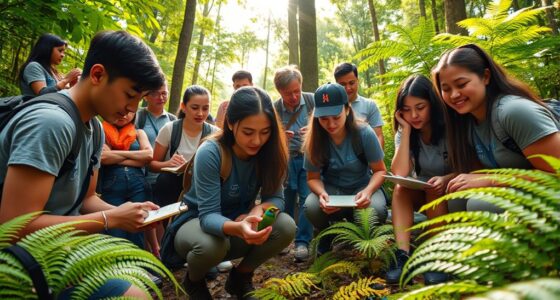You can help save endangered species like the Sumatran orangutan, the critically endangered vaquita, and the remarkable mountain gorilla. Your support aids conservation efforts for them and others like the Amur leopard, Sumatran elephant, and the majestic whooping crane. Don’t forget about the leatherback turtle, North Atlantic right whale, and the Sacramento River winter-run Chinook salmon, all facing serious threats. There are many ways to make a difference, and there’s more to explore about these amazing species.
Key Takeaways
- Support conservation organizations focused on species like the Sumatran Orangutan and Vaquita to combat habitat loss and illegal fishing practices.
- Participate in community efforts to protect the California Condor by reducing lead poisoning and promoting habitat conservation.
- Purchase trekking permits to aid the conservation of Mountain Gorillas and raise awareness about their ongoing protection needs.
- Advocate for sustainable fishing practices to help protect the North Atlantic Right Whale from entanglement and vessel strikes.
- Engage in habitat restoration projects for endangered species like the Sacramento River Winter-run Chinook Salmon to ensure their survival.
Sumatran Orangutan
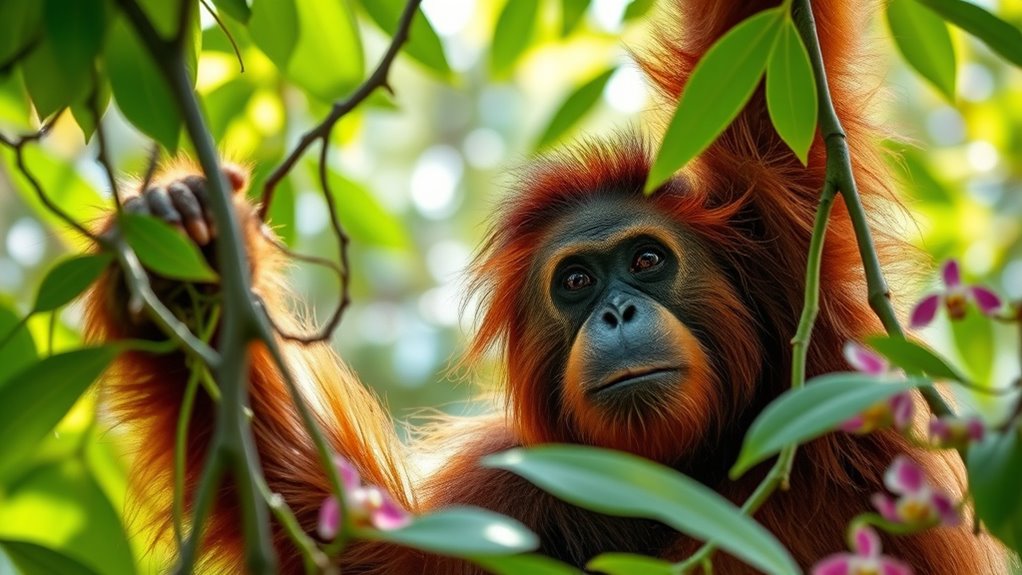
The Sumatran orangutan, a fascinating and critically endangered primate, calls the lush forests of northern Sumatra home.
You’ll find them primarily in Aceh and North Sumatra, thriving in moist lowland forests, montane forests, and peat swamps, usually between 200 to 400 meters above sea level. Observing animal behavior can provide insights into their habitat needs and survival strategies, as understanding these factors is essential for mental health and resilience in conservation efforts.
With a remaining population of about 13,800 individuals, their numbers have drastically declined due to habitat loss from deforestation and illegal activities.
These semi-solitary creatures communicate through gestures, boasting a repertoire of 64, with 29 carrying specific meanings.
As they face increasing threats, including unsustainable palm oil production, your support in conservation efforts—like protecting their natural habitat—can make a significant impact. Additionally, Sumatran orangutans exhibit bimaturism in males, which allows for both flanged and unflanged males to reproduce.
Help ensure their survival for future generations.
Amur Leopard
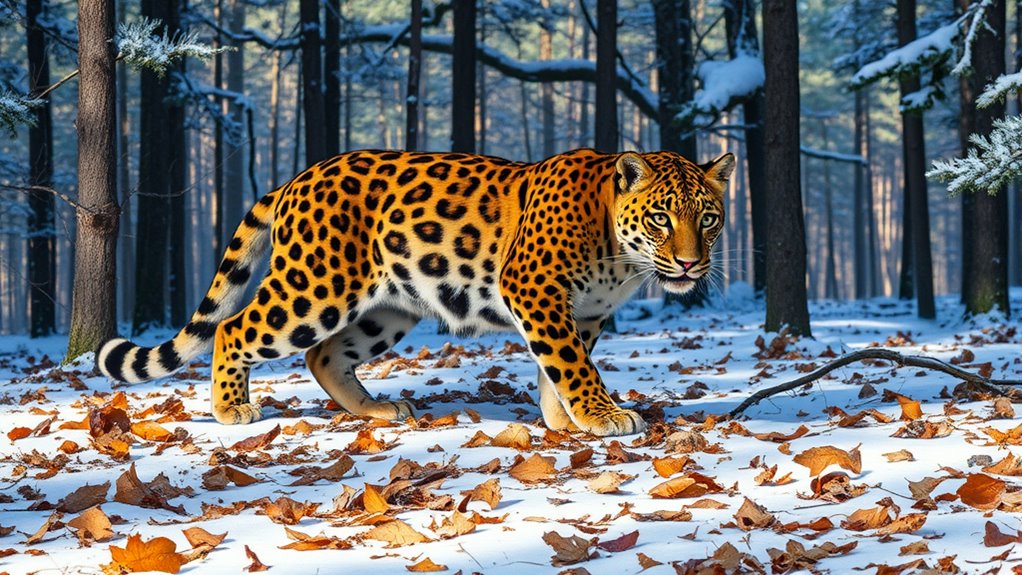
While wandering through the temperate forests of the Russian Far East and Northeast China, you might catch a glimpse of the elusive Amur leopard, a critically endangered big cat known for its stunning beauty and remarkable adaptations. Weighing between 70 and 105 pounds, this agile predator boasts a thick winter coat that provides warmth and camouflage. With a population of around 84 individuals, their numbers are slowly increasing due to dedicated conservation efforts. However, threats like poaching and habitat loss persist. The Amur leopard plays a crucial role in maintaining ecological balance, preying on deer, boar, and hares. Solitary animal that hides unfinished kills to avoid other predators, the Amur leopard showcases its unique behavior as it navigates its challenging environment. Additionally, the protection of species like the Amur leopard is essential for maintaining ecological balance, as their presence helps regulate prey populations and supports overall biodiversity. Conservation efforts not only protect these majestic creatures but also contribute to overall health of the ecosystem they inhabit. Understanding their role is crucial for cost variances in conservation budgeting, ensuring resources are effectively allocated to protect these endangered species.
Vaquita
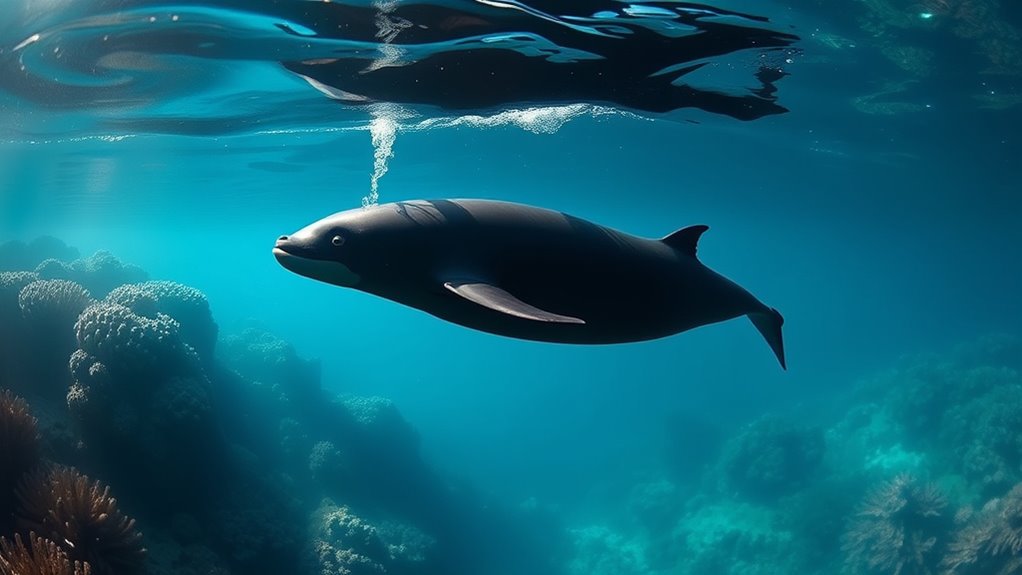
Known as the “little cow” in Spanish, the vaquita is a critically endangered marine mammal that captivates with its unique charm and vulnerability.
Discovered in 1958, these small cetaceans measure up to five feet long and weigh around 120 pounds. They inhabit the northern Gulf of California, where fewer than 20 vaquitas remain. As of February 2022, fewer than 10 vaquitas were believed to be alive, highlighting the urgency of conservation efforts. The situation is reminiscent of narcissistic tendencies observed in relationships where the focus on self-interest leads to detrimental outcomes for others. Their existence is threatened primarily by entanglement in gillnets used for illegal totoaba fishing, which often results in permanent hearing loss for the vaquitas due to the stress and trauma of entrapment. Protecting the vaquita is crucial not only for its survival but also for maintaining healthy ecosystems that depend on diverse marine life.
To help save the vaquita, support conservation organizations working to enforce gillnet bans and promote sustainable fishing practices.
You can also spread awareness about the importance of protecting their habitat and the biodiversity of the Gulf of California.
Every action counts in the fight to preserve this remarkable species.
Mountain Gorilla
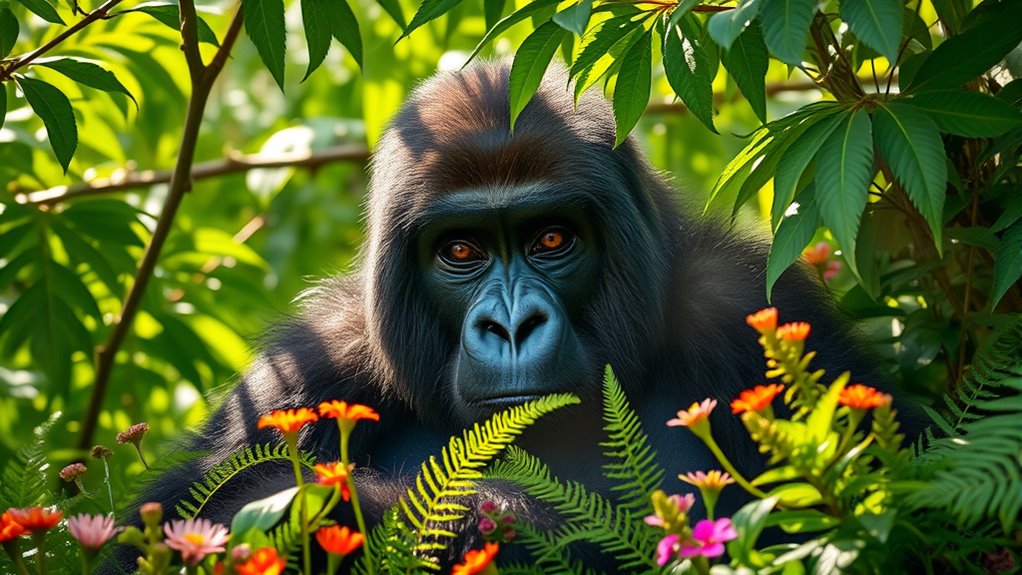
As you explore the majestic landscapes of East Africa, you might encounter the mountain gorilla, a remarkable species that has made a comeback thanks to dedicated conservation efforts.
With a population now exceeding 1,000 individuals, these incredible creatures have seen a 26.3% increase in seven years, largely due to anti-poaching patrols and veterinary interventions. Organizations like the International Gorilla Conservation Programme, WWF, and CI are crucial in protecting their habitats within national parks. However, this success is threatened by ongoing global challenges such as habitat loss, poaching, and human diseases that still jeopardize their survival. Child support obligations must also be managed in conservation efforts to ensure sustainable funding. You can support their conservation by purchasing trekking permits, donating to organizations, and spreading awareness. Additionally, their diet primarily consists of leaves, shoots, and stems, which highlights the importance of preserving their natural habitat for their continued survival. Emergency preparedness essentials are also vital for communities living near these habitats to ensure human-wildlife coexistence.
Every action helps ensure these intelligent, social great apes continue thriving in their natural habitats.
Sumatran Elephant
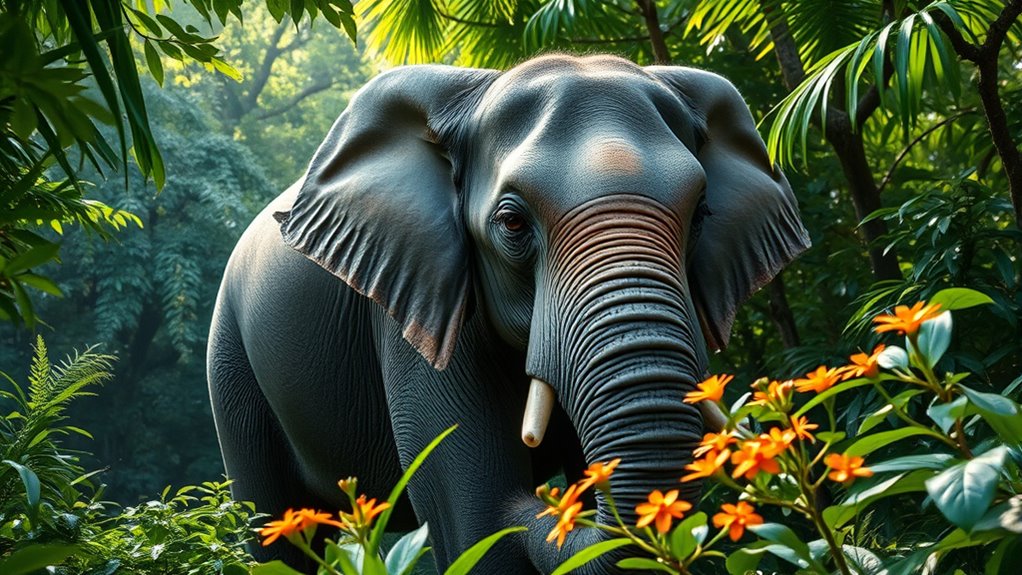
If you venture into the lush forests of Sumatra, you may encounter the Sumatran elephant, a critically endangered subspecies of the Asian elephant. These magnificent creatures primarily inhabit moist tropical forests, but habitat loss has drastically reduced their numbers, with estimates now between 924 and 1,359 individuals. Once roaming freely across the island, their populations are now isolated due to severe fragmentation, increasing the risk of inbreeding. They play a crucial role in maintaining forest health by dispersing seeds, and their emotional and social complexity mirrors that of animals with Borderline Personality Disorder. However, threats like poaching and human-elephant conflict continue to jeopardize their survival. Unfortunately, 69% of potential Sumatran elephant habitat was lost between 1980 and 2005, highlighting the urgent need for conservation efforts. To effectively combat these threats, it is essential to adopt data-driven decision-making that informs strategic conservation initiatives. Additionally, understanding filial responsibility laws can help secure funding for conservation projects that protect these majestic animals and their habitats.
California Condor
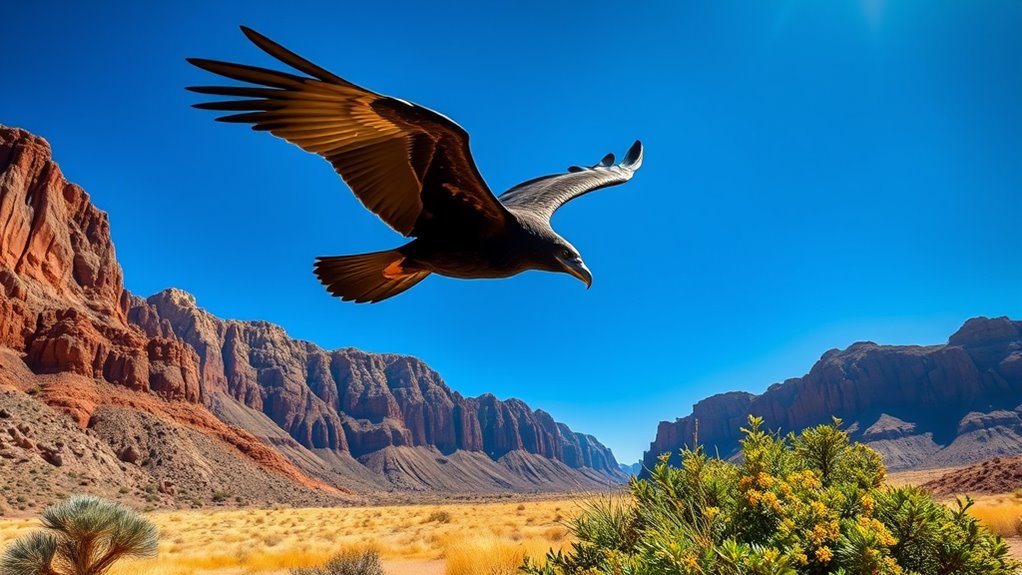
Although they once soared majestically over the western United States, California condors now face a precarious existence as one of the world’s most endangered birds.
Weighing between 20-25 pounds, these magnificent vultures boast a wingspan of about 9.5 feet and have inhabited our landscapes for over 40,000 years. California condors have existed since the late Pleistocene Era, which highlights their long-standing presence in the ecosystem. Additionally, creating Backyard greenhouses can also provide a space for growing native plants that support local wildlife. Hydrogen can be produced from renewable energy sources, which can help mitigate the environmental impact on their habitats.
Sadly, lead poisoning from ammunition and ingestion of microtrash threaten their survival.
Conservation efforts, including captive breeding and habitat protection, have helped increase their population to around 410, with over 300 living in the wild today. These efforts demonstrate the importance of community involvement in preserving endangered species.
You can make a difference by supporting lead-free ammunition initiatives, adopting a condor, or reducing waste in their habitats.
Every action counts in safeguarding this incredible species for future generations!
Whooping Crane

When you think of majestic birds, the Whooping Crane likely comes to mind, standing tall as North America’s tallest flying bird at up to five feet. Known scientifically as *Grus americana*, these cranes are endangered but show signs of recovery, with about 599 individuals remaining. Their breeding grounds lie in Wood Buffalo National Park in Canada, while they winter at the Aransas National Wildlife Refuge in Texas. You can help by supporting conservation efforts, like captive breeding programs and legal protections under various acts. Their diet includes blue crabs and small rodents, but habitat loss and migration threats still challenge their survival. The Whooping Crane prefers breeding grounds like marshes and shallow lakes, and finding clean water sources is essential for their habitat’s overall health. By raising awareness and advocating for their protection, you can contribute to securing their future. Additionally, preserving their habitats supports common health concerns that affect many wildlife species. To further aid their survival, consider investing in durable survival gear that can be used in conservation efforts and outdoor education.
Leatherback Turtle
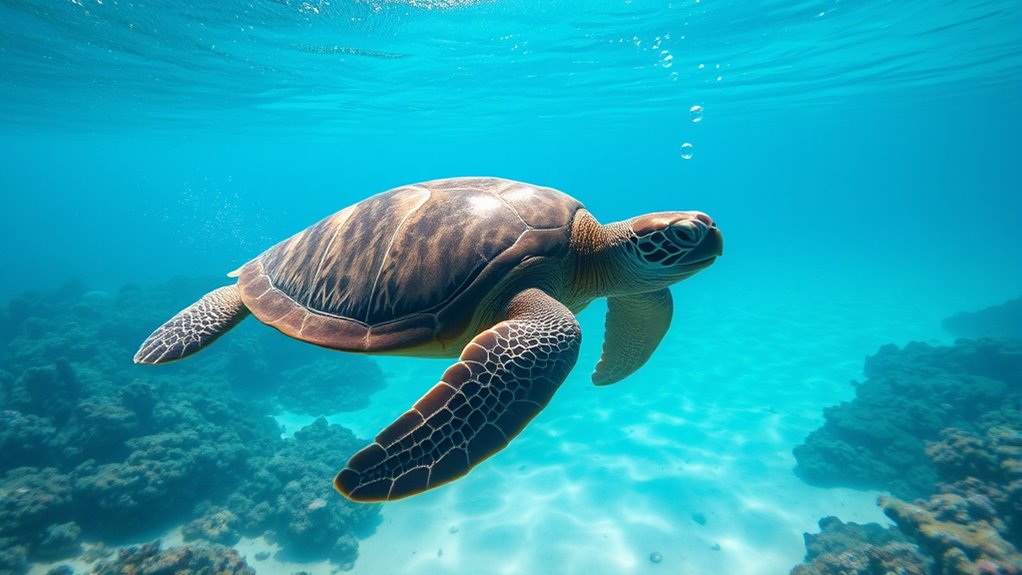
After exploring the magnificent Whooping Crane, it’s time to turn your attention to another remarkable creature of the wild: the Leatherback Turtle.
Known scientifically as *Dermochelys coriacea*, these turtles are the largest reptiles by weight and are vital to ocean ecosystems. Unfortunately, they’ve been listed as endangered since 1973, facing threats like bycatch in fishing gear, plastic pollution, and climate change. As a keystone species, leatherbacks help regulate jellyfish populations, which is essential for maintaining the balance of marine life. Their role is crucial in preventing cognitive decline in Parkinson’s associated with the loss of biodiversity. Additionally, their decline highlights the urgent need for conservation efforts to protect marine ecosystems. Furthermore, investing in conservation initiatives can significantly boost the effectiveness of efforts to safeguard these turtles.
Their population has plummeted by 40% in just three generations, with some subpopulations critically endangered. You can help by supporting conservation organizations like NOAA Fisheries and Turtle Island Restoration Network, advocating for reduced plastic use, and backing efforts to protect their nesting habitats.
With a 40% population decline in three generations, supporting conservation is crucial for the survival of Leatherback Turtles.
Every action counts in the fight to save these incredible creatures.
North Atlantic Right Whale

As you delve into the plight of the North Atlantic right whale, you’ll discover a species teetering on the brink of extinction. With only about 372 individuals left, fewer than 70 of those are reproductive-age females, making survival increasingly precarious. The population is steadily decreasing, and there is a risk of functional extinction within a lifetime.
Unfortunately, the population trends show more declines than increases. Major threats include entanglement in fishing gear and vessel strikes, both leading to high mortality rates. Noise pollution and climate change also threaten their habitats and food sources.
Conservation efforts are underway, including vessel speed restrictions and innovative fishing technologies to minimize entanglements. By supporting these initiatives and using tools like the Whale Alert app, you can play a crucial role in helping this majestic whale recover from the brink.
Sacramento River Winter-run Chinook Salmon

The Sacramento River winter-run Chinook salmon, a symbol of California’s natural heritage, faces an uphill battle for survival as it clings to its endangered status under the Endangered Species Act.
Once boasting a population of around 200,000 spawning adults annually, these salmon now struggle due to climate change, habitat loss, and diseases. They require cold water for spawning, which is often compromised by damming and water management issues. Currently, their spawning occurs downstream of Keswick Dam, limiting their historical range. Conservation efforts are underway, focusing on habitat restoration in areas like Battle Creek, with an emphasis on addressing key threats identified such as altered water flows and increased disease prevalence.
Frequently Asked Questions
How Can I Report Poaching or Illegal Wildlife Trade?
If you witness poaching or illegal wildlife trade, it’s vital to act quickly.
You can call local law enforcement or wildlife authorities to report the incident. Utilize hotlines like the U.S. Fish and Wildlife Service’s TIPs line for easy reporting.
Don’t forget to provide detailed information, such as locations and vehicle descriptions.
If you prefer, you can also use online tools to submit tips anonymously, ensuring your identity stays protected.
What Are the Best Ways to Support Conservation Organizations?
To support conservation organizations, you can donate money or time.
Consider making a recurring donation for steady support, or target your contributions towards specific causes.
Volunteering on-site or using your skills for virtual projects can make a real difference.
Attend events to engage with the community and learn more.
Finally, stay informed and use social media to raise awareness about conservation efforts.
Your involvement can significantly impact these vital initiatives.
How Do Climate Change and Habitat Loss Affect Endangered Species?
Climate change and habitat loss threaten endangered species in profound ways. They disrupt food sources, fragment habitats, and increase extinction risks.
You’ll see species struggling to adapt as warmer temperatures alter their environments, while others face increased diseases.
As habitats shrink, competition intensifies, making survival even harder. You can imagine the challenges these species encounter with disrupted breeding cycles and diminished genetic diversity, all leading to a fragile future for our natural world.
Can I Volunteer for Local Wildlife Conservation Projects?
Yes, you can definitely volunteer for local wildlife conservation projects!
Many organizations, like the Nature Conservancy, offer opportunities that fit various interests and skills. You’ll find roles in ecological restoration, species monitoring, and community education.
Don’t worry if you lack experience; most projects welcome volunteers of all ages and abilities.
Plus, you’ll enjoy the benefits of spending time in nature while making a meaningful impact in your community.
What Are the Impacts of Pollution on Endangered Marine Life?
Imagine a sea turtle mistaking a plastic bag for jellyfish. As it swallows the plastic, its stomach fills, leading to starvation.
Pollution severely impacts endangered marine life, causing ingestion, entanglement, and habitat destruction. Chemical runoff can create toxic algal blooms, harming food sources.
Noise pollution disrupts communication and behavior, leading to strandings.
Your awareness and actions can contribute to reducing these pollutants and protecting vulnerable marine ecosystems.
Conclusion
By supporting these endangered species, you’re not just saving animals; you’re also preserving the delicate balance of our ecosystems. Every little bit helps, whether it’s through donations, spreading awareness, or volunteering your time. Remember, it takes a village to make a difference, and your efforts can really go a long way. So, roll up your sleeves and dive in—together, we can ensure these incredible creatures have a fighting chance for a brighter future!



